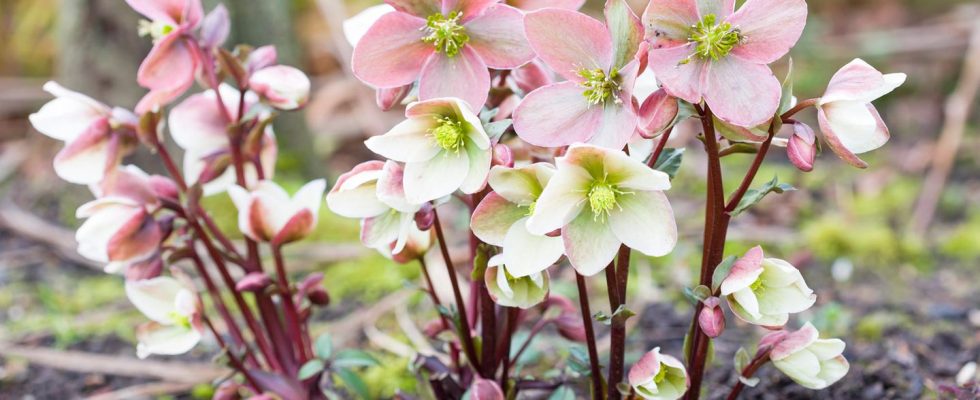Cold season
How to conjure up a sea of flowers in your garden with hardy perennials
Christmas roses are among the hardy perennials that don’t mind frost and cold
© PaulMaguire/Getty Images
Perennials have two advantages over other plants: they are perennial and hardy. The easy-care and robust plants are ideal for hobby gardeners who have little time or experience. We introduce you to five varieties.
The ideal time windows for planting hardy perennials in the garden are spring and autumn. The outside temperatures are neither too hot nor too cold. In addition, it usually rains enough and you therefore rarely have to water. What you should pay attention to before planting, however, is the individual needs of a plant’s location. Depending on which perennial you choose, a sunny, partially shaded or shady place is preferred. The type of soil also plays an important role. Below we will introduce you to five winter-hardy and perennial varieties, including their special environmental requirements.
These hardy perennials enchant the garden
1. Christmas rose
This is a robust and easy-care winter perennial Christmas rose. It blooms between November and March, adding colorful accents to your garden during the cold season. Even snow can’t harm the plant (and its flowers), it just leaves its leaves hanging when there’s frost to protect itself – as the temperatures rise, the foliage stands up again. The Christmas rose grows on almost all types of soil, but it cannot tolerate waterlogging.
Flowering time: | November to March |
Location: | sunny to shady |
Growth height: | approx. 40 cm |
2. Ornamental grasses
So-called ornamental grasses bring fresh green into the garden – such as this trio, consisting of three varieties (Festuca glauca Elijah Blue, Festuca gautieri, Festuca Golden Taipee). The hardy perennials offer a colorful variety of colors – from green to blue to light green. The perennial plants grow particularly bushy and yet have fine, long stalks. One of their special features is that they are drought-resistant.
Flowering time: | Summer |
Location: | sunny to partially shaded |
Growth height: | approx. 20 to 30 cm |
3. Autumn aster
Autumn asters are among the hardy, bee- and butterfly-friendly perennials. Especially the new breed ‘Alpha®’ Light Pink has many, color-stable violet to pink flowers that will really make your garden shine – preferably in a sunny location. The perennial plant is equally suitable for beds and flower pots, requires little water and is therefore very easy to care for.
Flowering time: | from September |
Location: | sunny to partially shaded |
Growth height: | approx. 40 cm |
4. Sunflower
Unlike common sunflowers, it’s the variety that counts ‘SunCatcher®’ (a new Helianthus variety) is one of the hardy flowering perennials. The bee-friendly, perennial plant has golden-yellow flowers that last from July to October. It is important to know: If you cut off the withered stems, new ones will grow back there. The sunflower is quite easy to care for and needs nutrient-rich soil to bloom for four months.
Flowering time: | July to October |
Location: | sunny to partially shaded |
Growth height: | approx. 120 cm |
5. Hibiscus
The perennial hibiscus ‘Summerific®’ ‘Midnight Marvel’ is also one of the hardy perennials. The new breed is said to grow even more branched and bushy than its close relatives. So that the scarlet flowers and dark leaves can develop their full splendor, you should provide the plant with permeable and nutrient-rich soil – ideally in a protected location.
Flowering time: | June to September |
Location: | sunny to partially shaded |
Growth height: | approx. 100 cm |
(Care) tips for hardy perennials
Depending on when hardy perennials are planted, the plants go through different stages:
- If they were planted in the ground in spring, most varieties will bloom the following summer or otherwise in autumn.
- If they were placed in the ground in autumn, the plants concentrate on their root growth and bloom again the next year.
Basically, hardy perennials have the ability to pull in all parts of the plant that are above the ground – or they die. However, that’s not a big deal because the plants sprout again in spring.
Tip: Before planting a hardy perennial, you should loosen the soil and remove any weeds with strong roots. Ideally, you should mix some compost (not fertilizer) into the soil – if it is particularly loamy, it makes sense to add some sand as well. This will prevent waterlogging. Last but not least, another tip is not to remove wilted foliage in the fall as it protects the plant from the cold.
You might also be interested in:
This article contains so-called affiliate links. Further information are available here.



